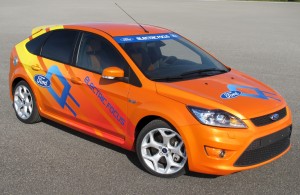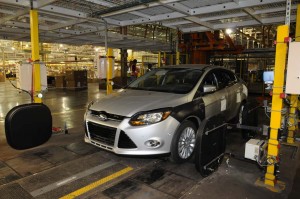With a $550 million upgrade largely completed, Ford Motor Co.’s Wayne Assembly Plant will become battery central for the automaker, rolling out an assortment of new electric vehicles due to start production next year.
The suburban Detroit facility will be able to produce a mix of battery-based hybrids, plug-ins and pure battery-electric vehicles, or BEVs, as well as conventional gasoline-powered models, Ford officials revealed Tuesday, during a tour of the assembly plant. Ford is anticipating a sharp increase in demand for “electrified” products, according to Mark Fields, President of Ford of the Americas.
In fact, Ford is markedly more bullish than most of its competitors. Depending on where federal regulators eventually decide to push the nation’s fuel economy standards – and a jump to 62 mpg by 2025 is under serious study – battery power could become critical. At the very least, he said, various forms of hybrids, plug-ins and BEVs should account for a collective 10% of Ford’s fleet by 2020 – at the minimum. And that could jump as high as 25%.

A battery-powered Ford Focus will be the first electric vehicle to roll down the line at the Wayne Assembly Plant, starting late next year.
Last week, Ford and its partner, Canadian-based Azure Dynamics, shipped their first battery-electric version of the Transit Connect van. That largely hand-built model is being assembled at a small facility in the Detroit suburbs and is expected to generate less than 1,000 sales annually. But Ford has decidedly bigger hopes for a battery-electric version of its next-generation compact Focus model.
The Focus Electric will be assembled on the Wayne assembly line, alongside the conventionally-powered model, which is just going into production. Eventually, Ford will add two other battery models at the plant, a plug-in hybrid and a conventional hybrid. The maker is expected to provide more details about those projects at the Detroit Auto Show, next month.
(Ford hopes to add Stop/Start technology, which could improve mileage by 10%, to much of its line-up. Click Here for more.)
To prepare for Focus – and the various gas and battery-powered models to come – Ford completely tore up the aging Wayne plant, which used to be one of its core truck facilities. Some analysts call the move risky, as the small cars that will be produced at Wayne generate significantly lower margins than light trucks.
“But we’re going to counter that with scale,” insisted Ford CEO Alan Mulally, noting that the maker eventually plans to produce 10 different variants off its so-called Global C-Car platform, generating a collective 2 million units of volume annually. Since the underlying components will largely be shared from vehicle to vehicle and market to market, that will help the company earn money in market segments that used to be money pits, according to Mulally.
For the moment, Wayne Assembly has become the most modern factory in Ford’s global empire, according to Jim Tetreault, the maker’s chief of production for North America. “We’ve modernized just about every square foot of this facility to establish a new standard for high-tech, green, flexible and efficient auto factory.”
The 1.2 million square-foot plant will be the first in the world, the executive noted, to produce not only conventional vehicles but also three battery-based models.
While that will make Wayne one of Ford’s “greenest” assembly lines, the maker has also taken steps to ensure the facility operates in an environmentally-friendly manner. Among other things, Wayne will generate some of its electricity from new solar panels capable of producing up to 500-kilowatts of power – the largest such system in Michigan.

